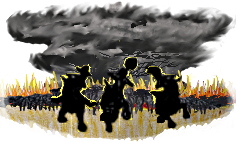Kit Carson's Ride

Sic Transit Gloria Mundi
Here today, ...
The interesting thing about Joaquin Miller is the fact that everyone in America knew him in 1913 and in 2017 absolutely no one knows him. This is often the case with celebrities and Miller was one of the first celebrities, a person who built a career on being famous. Miller's model was Byron but it is significant that he put his energy not into writing like Byron but into dressing like him. It was the persona of the GREAT POET that interested him. Unfortunately, his poetry was not very well received in his native land and the Great Poet needs at least a good audience if not a great one.
A Celebrity is Not Without Popularity
Except in his own country
In order to gain that audience he became one of the originators of the star-maker machinery that we know so well today. When it is hot, it creates celebrities known to all and when the machine is no longer being stoked, the star goes dim and finally vanishes completely. The question remains whether he invented the machine or stumbled upon it by accident. Possibly a little of both. The move to London was deliberate and it was the necessary step in achieving celebrity status. But I doubt that he foresaw how it would play out. A large part of his success was the happy coincidence that in addition to being from a fabulous but relatively little known region, he was naturally theatrical and fond of dressing up in outlandish costumes. Thus, one of the things that made it hard for him to be taken seriously at home, made him more interesting when transplanted to the capital of the English speaking world.
If You Must Steal,
Steal from the best
The first version of "Kit Carson's Ride" was written during Miller's London stay and was his first commissioned piece, a milestone in the career of any writer. It was modeled on Robert Browning's "How They Brought the Good News from Ghent to Aix." But that modeling highlights Miller's weaknesses. Browning sticks to six line stanzas, with Miller every stanza is a different length and the same looseness appears in the meter and rhyme. Miller starts with a good idea suited to his talents: a wind driven prairie fire driving all before it and moving faster than animals can run. Then he spoils it by imitating Browning's structure of three riders dropping off one by one until only the narrator is left at the end. Then, seeking notoriety, he names it "Kit Carson's Ride" not because anything in the poem requires it but because Kit Carson is famous. Later, this will come back to bite him, but in London Carson is known but not idolized so for now it is OK. This is not even one of Miller's better poems but it got published and I presume he was paid, so it counts as a success.
It Pays to Advertise
If you can afford it
One interesting note about Miller's London stay is that all of his London publications were heavily promoted by ads in various newspapers throughout England. It would be interesting to know who paid for these ads. Probably it was either his publisher or one of Miller's friends. Miller's early career got a substantial boost from various friends in both San Francisco and London. A contemporary who new him fairly well called him "the most genial man I ever knew" and from the evidence of his London adventures he was a lot of fun at parties. Perhaps this was another component of the 19th century star maker machine. A contemporary writer, Ambrose Bierce, wrote a perceptive remark in a review of Miller's poetry. Bierce was noted for his caustic reviews but his treatment of Miller's work was relatively gentle but he noted that it was difficult to accurately gauge the work of a living artist because the evaluation of the work is necessarily affected by the evaluation of the artist. In Miller's case this was especially true. Miller's poems without Miller would probably never have appeared commercially.
Maybe Not Great Art
But genuine history
Now that Joaquin Miller is not around to entertain us in person, what should we think of him today? I freely acknowledge that his artistic output spans the gamut from mediocre to just plain bad. As a historic character though, he is very interesting. He was a chronicler of a time and place where most of his companions were too busy to leave any records at all. He did live with the Indians when they were still a presence in the mountains of Northern California, he was part of life in the gold camps when they were still at their rawest and wildest. He must be taken with caution but every now and then a detail pops up that sheds new light. I have never seen anywhere else that in every gold camp saloon the bar was backed by sand bags to give the bartender shelter when things to too hot. And one of his recurring characters was the whore named "Bunker Hill" on account of the noticeable hump on her back which gives me a probably much more accurate picture of what the red light districts in the gold camps of '49 were really like.
